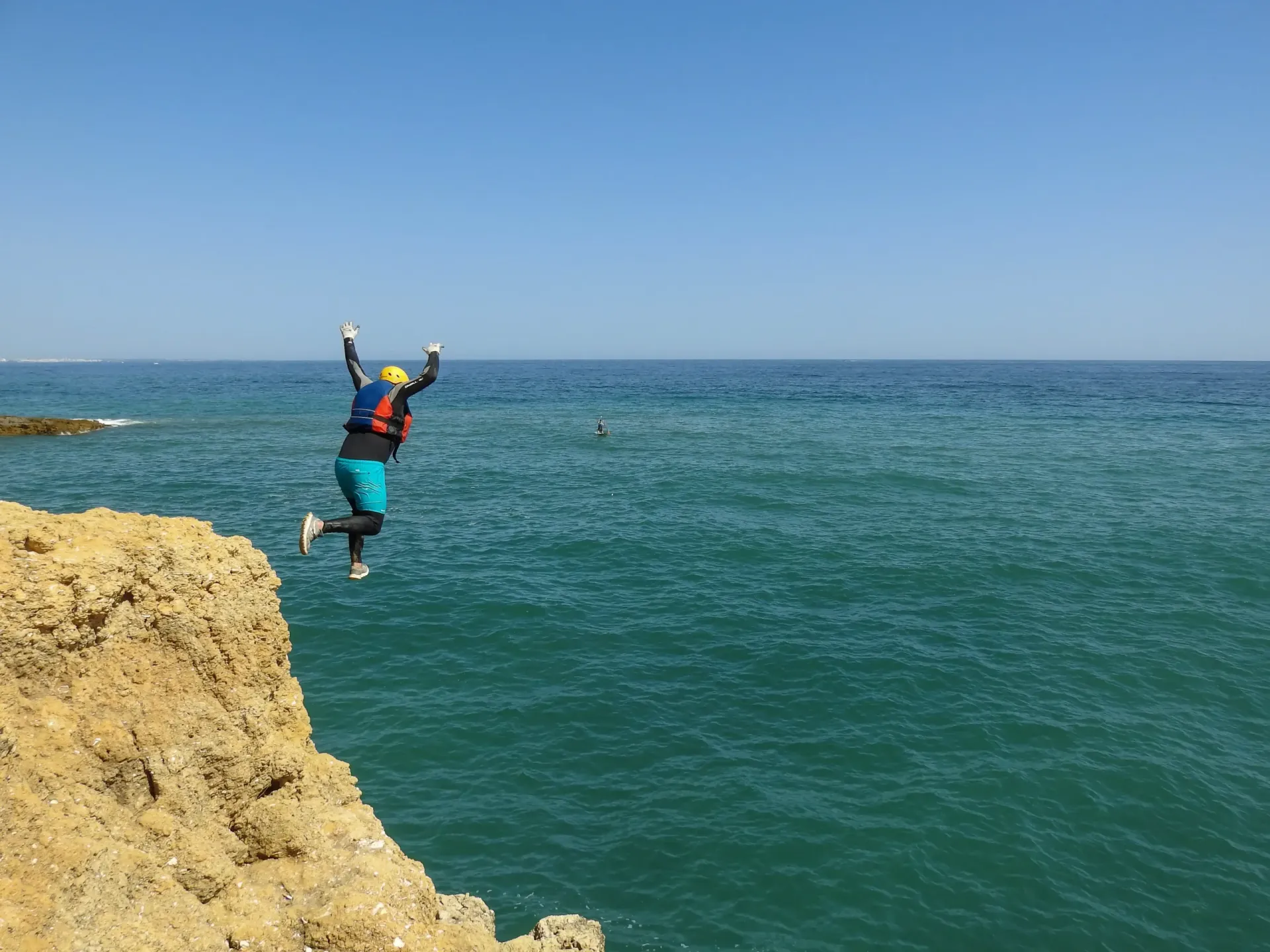Have you always wanted to test your skills, adrenaline and nerves? It seems that cliff diving – also known as “cliff jumping” – could be your new favorite sport.
Imagine jumping off a high cliff just for the surrounding nature. Everything is silent except for the sound of the ocean waves. After a brief moment, you feel the force of gravity pulling you down towards the translucent water.
Sound scary or encouraging? Either way, read on to learn more about this breathtaking sport and see extraordinary images of cliff jumping.
We’ll break down the most important things to know about cliff jumping, as well as give you a top 3 places to try for yourself. And most importantly, how to do it safely (well, as safe as possible, anyway).
What is Coasteering?
Before talking about Cliff Jumping, we have to see what Coasteering is, since it is very common to confuse the two terms.
Coasteering is an amazing new sport developed in the UK by adventurers who wanted to explore the coasts in a different way. It combines several adventure sports into one. Climbing, swimming and jumping alone are a lot of fun physical activities. Therefore, when combined the pleasure increases exponentially!
Coasteering allows participants to take coastal exploration to the next level. Imagine walking to the edge of a cliff and, instead of just looking, jumping several meters into the water!
This sport takes enthusiasts from the coast to the ocean, where they can explore caves and some of them are untouched. A coasteering adventure is an affordable, familiar and safe activity.
Who can practice Coasteering?
Anyone can do this activity, with a few small exceptions. Minimum ages for children vary by location. Normally, children aged 8 and over can already practice. However, in some places, such as S. Rafael beach, the minimum age is 14 years old. Several companies may also offer introductory course options for younger children. Check the activity description for specific age requirements.
There are a few other exceptions to consider before coasteering. Firstly, it is recommended that participants feel comfortable swimming. The experience of swimming in waves is also convenient, but not necessary. Second, confidence walking on uneven terrain and climbing rocky areas is also advised.
Guided tours are led by professionals who are often also experienced in this type of activity. These guides know the behavior of waves and the most difficult areas that require a little more strength or technical maneuvers. So it is not necessary to have advanced knowledge, the guide will show you everything you need to do!
There are also alternative routes available along the way if an area seems too scary or advanced.

Why should you try coasteering?
Typically, tourists and hikers visit coastlines by walking only as far as the path allows and usually do not go further. The view is limited to looking at the horizon. Some of the braver ones approach the edge and look at the waves as they crash down below.
By coasteering, you will have access to areas of the coast that would not be visible otherwise. It is a totally immersive activity. It’s an amazing experience, especially with friends and family.
Those who have tried coasteering say they are big fans. Often, after completing their first hike, participants want to go again soon!
What’s even more amazing is that coasteering is for everyone aged 14 and over. The instructors offer a variety of courses for those who want to challenge themselves as well as for those who want a more relaxed coasteering adventure.

What does it take for coasteering?
When booking an activity, the company has almost all the necessary equipment. For example, they will provide helmets, wetsuits (for locations with cooler water), life jackets and proper footwear.
You’ll just need to bring your own bathing suit, towel and camera if you wish (the photos will be amazing, so don’t forget your GoPro!). For places with warmer waters and climate, it is advisable to bring water, sunglasses and sunscreen as well.
What is Cliff Jumping?
Cliff jumping is jumping off a cliff as a form of sport. When done without equipment, it can also be known as tombstoning. It is part of the sport of coastal exploration or “coasteering”. When performed with a parachute, it is known as base jumping. The cliff jump world record is currently held by Laso Schaller, with a jump of 58.8 m.
Cliff jumping is a sport in which practitioners jump off cliffs or other objects to enjoy the sensation of free fall and land in the water below. It might not sound that complicated, but there are many factors involved and the higher the cliff jump, the higher the difficulty.
Jump safety
Cliff jumping is a dangerous activity and must be treated with respect to avoid serious injury. Stepping too far out of your comfort zone or skipping the basics can and probably will go wrong.
This activity is a lot of fun, it causes incredible emotion, and with practice it can become a relatively safe sport, even at great heights. But it takes time to get there.
Let’s start with the safety aspects of the jump and what you should be aware of before you actually jump into the jump. So pay attention to the most common questions before cliff jumping:
Explore the water
Before proceeding with anything else, always check the tide conditions and the water around the jump area.
Take a mask and dive to control the depth of water, rocks, anything floating on or under the surface. When you’re sure you’re safe, go ahead and have fun!

HOW DEEP SHOULD THE WATER BE TO JUMP OFF A CLIFF?
This, of course, varies depending on how high you are jumping from. But in general, you should aim for something around 7 meters or more. This will be enough for just about any jump.
If you are jumping at heights over 25 meters, at least 10 meters is a good depth for safe entry.
With more practice and awareness, you’ll learn more about how much depth you need depending on the height of the jump.
NEVER JUMP ALONE
Not only is it much safer to have a friend you trust who will be there if something goes wrong, but it’s also much more fun.

How to jump off a cliff?
Now that you know how to jump safely, let the fun begin!
The first thing you need to learn is how to jump with minimal impact. Start with low jumps of 3-5 meters and practice jumping feet first, and when you reach the water, keep your arms together and your feet together pointed down.
It may seem indifferent at this point but mastering the landing is essential to running well at higher heights. Make sure you practice a lot before moving on to bigger challenges.
Dangers of cliff jumping
As mentioned earlier, jumping off a cliff can be made safer with a good mindset, training and safety precautions. But still, it’s a dangerous sport, and injuries do happen.
A practitioner can reach speeds of over 100 km/h before reaching the water, depending on the height, and a bad landing can have severe consequences. That’s why it’s very important to be well prepared, both physically and mentally.
We don’t want to scare anyone, cliff jumping is amazing! But it’s important to be alert to the dangers and know how to avoid them.
Top 3 best places for cliff jumping
If you are planning a trip to Portugal, don’t miss the opportunity to explore the Portuguese coast. Read on to see the top 3 of the best places in Portugal to experience coasteering.
1. Sesimbra, Portugal
Portugal in all its fullness is truly stunning and Sesimbra is especially known for having incredible natural landscapes. Some of the best-known places to visit are the Zambujal cave and the wonderful beaches.
The most popular beaches in Sesimbra are Praia do Meco (which includes three beaches: Praia das Bicas, Praia do Moinho de Baixo and Praia da Foz). Also known are Praia da Lagoa de Albufeira, Praia da California and Praia do Ouro.
In Sesimbra, Coasteering is one of the most appreciated activities by lovers of outdoor activities. This coasteering activity in Sesimbra is divided into four levels that reflect the different ocean conditions and difficulty levels of the tour. For example, the Blue Line indicates good conditions for both calm waters and winds.
This tour also includes an optional 8 meter coastal jump and 30 meter abseiling. Due to this useful rating system, coasteering in Sesimbra is a good place for visitors of all skill levels to enjoy this sport.

2. Arrábida National Park
This National Park is an absolutely stunning coastal reserve in south-central Portugal. Arrábida is full of wonderful beaches, such as Praia da Galapa, Praia de Albarquel and Praia dos Coelhos.
The beaches here offer white sand along with crystal clear waters. Perfect for lying in the sun, snorkeling and surfing.
You can also see several castles and churches in the region, such as the Convent of Santa Maria da Arrábida. This convent is a beautiful medieval structure nestled into the hillside. Nearby, there is also the Palmela Castle.
In Arrábida National Park it is possible to book a 3-hour coasteering activity, perfect for beginners and groups. Along the way you can see caves and epic cliff jumping spots. It is the perfect place for those looking for adrenaline and a beautiful landscape!
3. S. Rafael Beach, Albufeira
Next on this list of the best coasteering spots in Portugal is S. Rafael beach in Albufeira. The rocky coastline of southern Portugal in the Algarve region is the perfect location for an ocean adventure.
Albufeira is blessed with around 300 days of sunshine a year along this incredible coast, perfect for coasteering.


